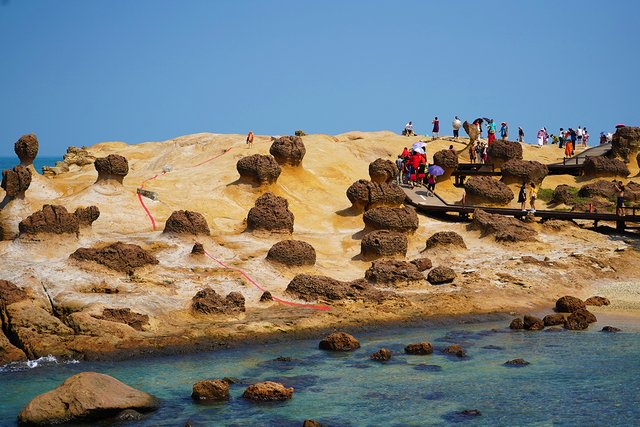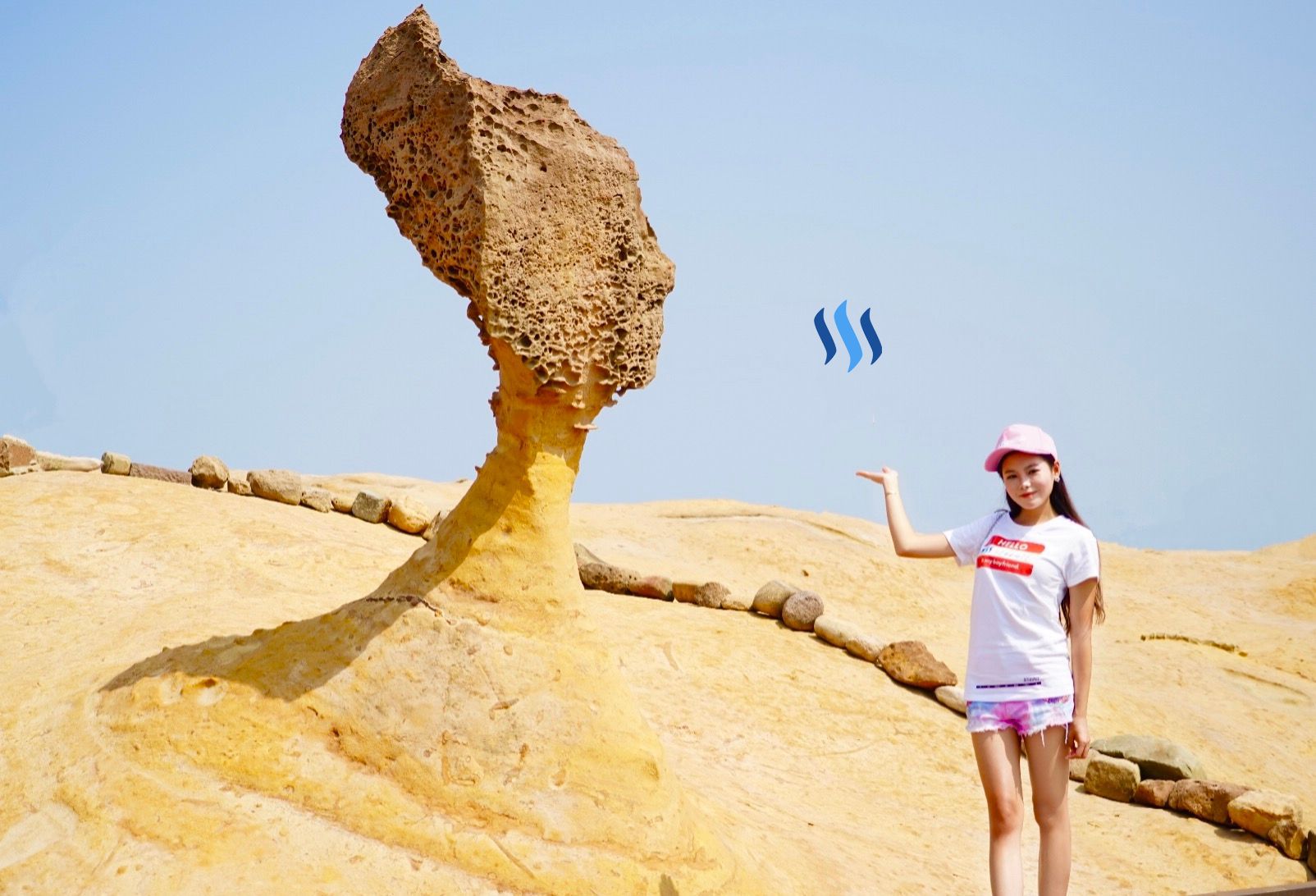Travel with me #94 : The Queens Head at Yehliu's Geopark!
There are so many reasons to visit the Formosan Island also known as Taiwan, and Yehliu Geopark is often near the top of the list of reasons. Geological formations resulting from thousands of years of attrition and erosion have gifted us with an unworldly composition of rocks. Perhaps the most iconic of these is the Queens Head, but aside from that one, there are also many other rocks in all sorts of shapes and sizes - many with their own nick names, describing their uncanny resemblances to worldly objects in the backdrop of alien landscapes. Therefore, a trip to Yehliu Geopark is like visiting another world, one with very appealing and unique geography.
The Queens Head is so iconic that it is often used as the unofficial emblem of the local town of Wanli. It, amongst other rock formations have stood against the geological forces overtime, contributing to their appearance today. It is however, a matter of time before these rocks lose their shapes forever as continuous natural geological forces erode them away.
Even though nature has it's way of going full circle, if you wish to see these natural rock formations in their mystical forms, it's definitely a good idea to visit sooner rather than later. I once visited the Azure Window in Malta, only to hear it had collapsed a year later. Nature works in mysterious ways, the beauty before us can come and then go, just like the tides from whence they were born.
Yehliu Geopark is part of the Wanli town and district, North East of Taipei along the coast. It is about 90 minutes via coach from Taipei Main Station, or about 1 hour via shuttle bus. My personal recommendation is to book a shuttle bus as they will come pick you up from your residence and drop you back as well. A common route is to pass by Keelung City on the way back. The vibrant bustling night markets there are a delight and draw visitors from all around.
From this aerial photo, you can see the 1,700 meters long cape of Yehliu Geopark, protruding out into the sea. This macro geological movement as a result of the Datun Mountains being forced out into the ocean as tectonic plates shifted.
The soft rocks here form a honeycomb like window lattice. Because of the monsoon season, the rocks are subjected to many months of hard battering under humid conditions. Uneven erosion under these severe weather conditions lead to the many holes. It's really as if the holes were created by creatures who live inside. (thankfully not!)
There is pretty much just one path that leads you all the way from the entrance of the park, right to the end of the cape, where you will climb several hundred meters up a fairly steep hill. At the top, there is a lighthouse.
Even though there are beautiful rocks everywhere you look, the attention is focused squarely on the Queens Head, the most recognisable and iconic rock formation of the park.
In the distance, you can see a little path with more people standing further away in the background. That is where the Queen's head is, as well as all the other Mushroom rocks.
In fact, all of the rocks were once spherical in shape. The thin pillars that we can now see supporting them are the result of faster erosion. This is due to more contact with seawater, and also because of the type of rock being more susceptible to erosion being the lower layer.
The result of this differential erosion is that we are left with the top rock layer containing more calcium, eroding slower than the lower rock layer.
There are three main types of these mushroom rocks. And they are all defined by the thickness of their 'necks' : Thin, thick, and neckless.
As time goes by, we will see the rocks cycle through neckless, thick and then thin necks as they continuously erode.
Lets take a look at some more of these amazing rocks below. Time to use your imagination and see if you can identify any of them!
A collapsed arch, a mini version of the azure window.
In the distance, you can see the cape of Yehliu, the lighthouse, and just below it, the 24 filial piety hill.
This rock has been given it's own name. You might have guessed that it is the Queens Head, but looking closely, you can see the shape is softer on the edges, almost resembling a little girl. Indeed, this mushroom rock is known as Cute Princess.
Nature's way of acknowledging the beauty of human form perhaps?
As you can see, this particular rock has a some what thin neckline. Yet, as you will see later, the Queens Head has an even thinner neckline. This means that the rock has been undergoing erosion for a very long time and that the weight of the head will soon overwhelming the neck supporting it, resulting in the head collapsing.
This is the reason that you will find sign posts for the Queen Head II and Cute Princess II near the entrance. They are replica's made from fibre-reinforced plastic, made in perfect 1 to 1 size and shape through computer modelling. In the event that the originals no longer stand, there are at least the replica's remaining.
A few foot bridges lead us to the main mushroom rock section.
Thick-neck mushroom rocks look very sturdy, and you'll notice that the honeycomb structures on top are a different kind of rock to the neck.
I believe this is supposed to be the Japanese Geisha rock. I'm not quite sure I see it, but it's certainly quite elegant and beautiful looking.
U5drPwtRvJTJdNbpDS8vZSpxboKXiep_1680x8400.jpg
Just to the bottom right where this picture was taken, is the Mazu cave. Mazu is the Chinese goddess of the sea, and the cave is named after her because of the statue that was previously placed inside the cave. Because of the frequent inclement weather conditions, the statue was moved away. Legend has it that Mazu made a presence before a fisherman demanding to be moved to Jinshang. This is where the Ci Hu Temple was then erected to consecrate the Sea Goddess.
This is the statue of Lin Tian Zhen. Most statues are erected as a sign of respect for high ranking person(s), or persons of notable importance. Lin Tian Zhen was an ordinary fisherman but with a heroic heart. On March the 18th, 1964, a group of students visited the area and one of them fell into the sea. This was before any security barriers were put up, nor was there any official scenic area for visitors. A local fisherman saw the student in the sea, and dived in to rescue him. Sadly, both ended up drowning and upon hearing this story, the President Chiang Kai-Shek ordered a statue to be built of Lin Tian Zhen in honour of his bravery.
DSC02558.JPG
I thought this shot was quite funny, look at all those umbrellas! (They're used to shade from the sun)
DSC02533.JPG
This is one of the 'Pineapple Bun' rocks sitting in a little notch on top of the larger bean curd like rocks. Who knew there can be food like rocks too!?
DSC02532.JPG
And finally, the star of the show! The Queen Head mushroom rock!As you can see, it's such an important and iconic rock that they have surrounded it with a perimeter of smaller rocks to stop people from touching it.
The man in the picture is standing on the walkway where people queue to take pictures.
According to geologists, the rock forming the Queens Head is around 4000 years old. It wasn't until around 1962 that the top part of the rock fractured and then broke off leaving the side of the head looking like side profile of Queen Elizabeth.
The neck of the Queens Head has suffered aggressive erosion over the years as well as perturbation from mankind. Though some measures have been put in place to try prolong the life of the Queens Head, it's collapse is an inevitability.
I'm very lucky to have a picture with the Queen Head whilst it's still standing. One of the reasons Yehliu Geopark is so popular is because of this landmark. Who knows what will happen when the Queens Head falls one day?

Hi! I am a robot. I just upvoted you! I found similar content that readers might be interested in:
https://steemit.com/travel/@sweetsssj/travel-with-me-94-the-queens-head-at-yehliu-s-geopark
Report Abuse of tag cn @incrediblesnow @abay